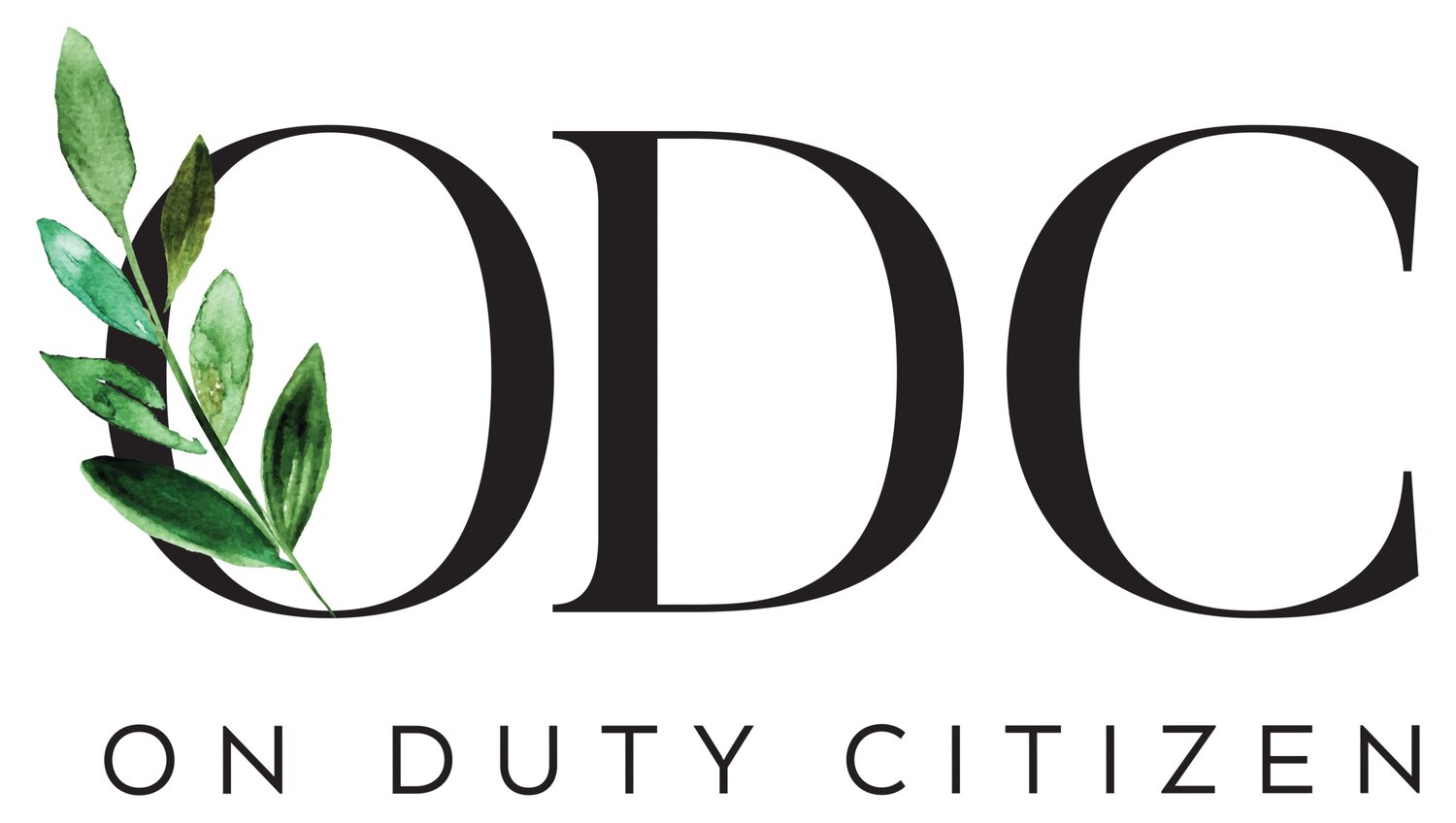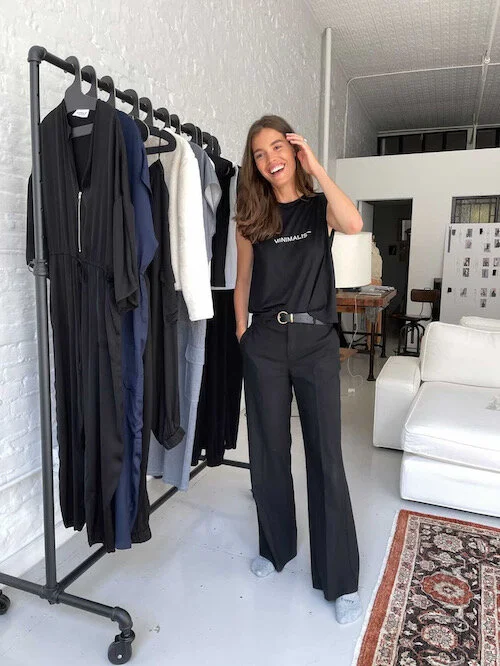Between Fashion Revolution Week April 23-29th and Earth Day on April 22, it’s an important time for us all to reflect on our positive and negative impacts on the environment.
Prior to starting ODC, I had little knowledge of the effects of fast fashion on our environment and on the people who make our clothes. $5 seemed like a bargain for a t-shirt and I found myself flocking to fast fashion retailers, desperate to buy the newest trends for as cheap as possible. Even being in the industry myself, having witnessed first-hand the difference between well-made clothes with beautiful fabrics and time consuming handwork and cheap fast fashion that felt as if it were about to fall apart, I found it hard to wrap my head around the fact that there is a crucial difference between a $5 throwaway and something that would cost me a lot but my last a life time. This is the problem many people face without even knowing it because of the marketing we are bombarded with each day. Consumers now expect to pay as little as possible for more clothing without realizing who is really paying for the pay-cut.
It wasn’t until living four and a half years in NYC as a full-time model that I began to realize the negative impacts of fast fashion. A fellow model and friend of mine, Cameron Russel had a meeting for models in NYC to talk about how to best use our platforms to advocate for matters that are important to us, for her it was women’s rights and the environment, especially fashion’s impact on the environment. It was at this specific meeting that I realized the fashion industry is one of the ‘dirtiest’ out there. In terms of pollution, worker’s rights and fabric waste, the industry has much to improve upon.
Something recent that ignited the fire for people to advocate for a better industry was the tragic Rana Plaza factory collapse in Bangladesh, five years ago on April 24, 2013. After numerous warnings that the building had visible dangerous cracks, workers were demanded to go to work regardless, and a day after many had complained, the building collapsed killing 1,138 people and injuring 2,500. It was the fourth largest industrial disaster in history. Tons of brands were identified in the rubble, many western , although it took many years for all those involved to own up to their involvement in this atrocious disaster. The disaster was fueled by political corruption and corporate greed perpetuated by the idea that our clothes needed to be made faster, be made cheaper all at the cost of the workers in third world countries where factories were unsafe and workers conditions were forgotten.
Now, five years what has changed?
Brands and customers seem to be more conscious of what they buy, what materials they’re using to produce clothing and who are the makers behind it all. The Fashion Revolution non-profit was made to promote genuine change and inspire others to be curious about where all their clothes are made. The industry hasn’t totally transformed but brands big and small are definitely taking strides to be more transparent about all their production processes, which is a huge step in the right direction. [1]
The Fashion Revolution created the hashtag #WhoMadeMyClothes? to inspire customers to reach out to the companies they buy from and see if they respond about their supply chain. Companies big and small including H&M, ASOS, and Adidas are working with their customers to share their suppliers, proof that some positive change is being made.
The Fashion Revolution organization also encourages easy steps for those in and outside of the fashion industry to take to ensure we’re all on the path to better production. These steps include an action kit with information on how to get involved globally at each and every fashion revolution week event. Things like printable posters to share on social media, campaigns to share with friends and followers on social media with important facts and quotes, encouraging consumers to share their fashion love story. The fashion love story should be used to write a love letter to a piece of clothing you already own encouraging consumers to shop less and find love in things they already own. Similarly, the organization created the hashtag #haulternative which inspires consumers to refresh their closets in a new way such as shopping secondhand, swapping with friends or doing DIY customization. The last steps to inspire change are to actively reach out to policymakers, writing letters to brands and then downloading their educational resources which includes worksheets, activities and information to show how you can be a student ambassador at your school.
Whitney Bauck, editor at Fashionista magazine is passionate about the intersection of fashion, faith and ethics and often writes about these issues, especially when they pertain to fashion. Since the factory collapse, Bauck explains another positive step towards ensuring a healthy and safe work environment in the Bangladeshi garment industry with The Accord, a five-year legally-binding agreement between large corporations and trade unions. [2] With the Accord in place, factories are continually inspected to ensure safe working conditions and are financially backed to upgrade safety measures. If you refuse to work with The Accord you could lose out on working with international brands that are signed up. Now, factory safety is no longer a “Western Luxury”. Because of these improved safety conditions, the amount of deaths per year has significantly dropped from 71 workers pre Rana Plaza to 17 workers annually now. [3]
There is however much more improvement needed. While the amount of unions surged immediately after the Rana Plaza disaster, activity has since slowed down, many people claiming to have been beaten up by police officials if they were involved in unions. There is hardly any backing of these unions from government officials. [4] Companies are pushing for safer working conditions yet often don’t want to pay for it. It’s tough without these unions to impose proper working wages or overtime pay for instance. [5]
In addition to these resources, I personally only try and shop from brands that are transparent about who makes their clothes, where they are made and the materials they use. There are enough brands out there doing it ‘right’ for me that I find I have enough resources available to shop. As of late, I’ve found I haven’t really had to buy any new clothes at all but will try and shop secondhand or swap with friends if I need something specific! It’s a fun way to spice up your closet, save some money and ensure you’re not contributing to environmental harm. Check out this article where I talk about a clothing swap I did with some friends in NYC!
With organizations like the Fashion Revolution, companies who are willing to change and friends and family who are inspired to do good, we can all work together to demand better conditions for all workers and for the environment we all often take for granted. Which leads to another important holiday that falls right before Fashion Revolution week, Earth Day!
Earth Day is a global annual celebration to demonstrate support for environmental protection. From the amount of plastic used, the amount of material waste, contaminated rivers and streams, greenhouse gas emissions, the food industry, makeup and hair, the list goes on about ways in which we can all collectively work to ensure better conditions for our environment.
With plastic waste alone, and even more specifically single-use straw waste, over 500,000,000 plastic straws are used EVERYDAY in the United States, many of which end up discarded in our ocean. It’s something so simple we can all say no to, to alleviate the amount of plastic ending up in our oceans and killing our ecosystems. I took the pledge to #stopsucking on single-use plastic straws and instead use bamboo straws if need be. Paper straws are a great alternative however if you don’t have to, using none is even better! Similarly, I always bring reusable bags to the grocery store, am never without my reusable water bottle and reusable coffee mug! I’m always on the go, so it also helps to have a metal fork and spoon on hand (I have a few in every purse). It’s little steps like this that we can all implement in our lives that will help make a difference. We can also reach out to our local restaurants, coffee shops (hello Starbucks!) and policymakers to address the abundance of plastic use and see if there’s a feasible solution that’s better for the environment.
This past Earth Day, I had originally planned to skip all the fun activities and watch a Raptors basketball game in D.C. which would include four + hour bus rides each way to and from NYC. What was environmentally friendly about that? Being stuck in a bus most of the day and contributing to the carbon footprint wasn’t ideal. We decided to skip the game and spend as much time as we could outdoors and ended up having one of the most fun weekends I’ve had in a while.
We started off our day by not using the lights as much as possible. Sure we had to get ready in a little bit of darkness but the light shining in from our windows did the trick. Next we went to our local coffee shop and used a cup to stay and my reusable mug. We then decided to do a 5k run and pick up trash along the way. This is called ‘plogging’ picking up trash while jogging and is huge in the Scandinavia. [6] It’s a fun way to keep our grounds clean and I must add definitely added a strength component to the workout! After our run, we made sure to bring our reusable bags with us and headed to the grocery store for a shop having them bag up everything in our own bags. Afterwards, we walked home along the east river and enjoyed the rest of the sunny day. It was a fun day outside where we got to admire mother nature and tried to make a difference where we could. It’s things we try and implement into our daily lives anyways but was a nice reminder to not leave the lights on, not have the tap run unnecessarily, pick up trash whenever you can and be cognizant of your impacts on the environment.
So, what changes are you going to make in your life? For our environment, for the people who make our clothes, for the companies we invest our money in and for the life we leave behind for future generations. Share some things you already do and what steps you’d like to implement into your lives, we’d love to hear your suggestions!
*Opening image shot by Leeor Wild for ADAY's new minimal waste campaign


